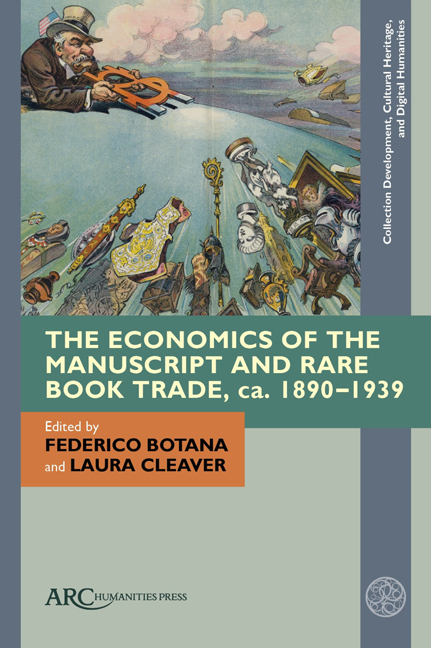Book contents
- Frontmatter
- Contents
- List of Illustrations
- List of Tables
- Acknowledgments
- Abbreviations
- Introduction. The Value of Rare Books
- Chapter 1 Valuing Rare Books in 1920s Germany: Prices in Jacques Rosenthal’s Bibliotheca medii aevi manuscripta
- Chapter 2 Leo S. Olschki’s Card Index and Potential Profits
- Chapter 3 Stock-books and Ledgers: J. & J. Leighton and Édouard Rahir and Company ca. 1897–1904 and E. P. Goldschmidt and Company ca. 1925–1933
- Chapter 4 Léopold Delisle, Henri Omont, and the Price of National Collecting: The Medieval Manuscript Acquisitions of the Bibliothèque nationale ca. 1900–1910
- Chapter 5 Herschel V. Jones: Public Collections and Private Investments
- Conclusion
- Appendix 1 Inflation
- Appendix 2 Exchange Rates
Chapter 2 - Leo S. Olschki’s Card Index and Potential Profits
Published online by Cambridge University Press: 28 March 2024
- Frontmatter
- Contents
- List of Illustrations
- List of Tables
- Acknowledgments
- Abbreviations
- Introduction. The Value of Rare Books
- Chapter 1 Valuing Rare Books in 1920s Germany: Prices in Jacques Rosenthal’s Bibliotheca medii aevi manuscripta
- Chapter 2 Leo S. Olschki’s Card Index and Potential Profits
- Chapter 3 Stock-books and Ledgers: J. & J. Leighton and Édouard Rahir and Company ca. 1897–1904 and E. P. Goldschmidt and Company ca. 1925–1933
- Chapter 4 Léopold Delisle, Henri Omont, and the Price of National Collecting: The Medieval Manuscript Acquisitions of the Bibliothèque nationale ca. 1900–1910
- Chapter 5 Herschel V. Jones: Public Collections and Private Investments
- Conclusion
- Appendix 1 Inflation
- Appendix 2 Exchange Rates
Summary
BESIDES BEING A well-known publisher, Leo S. Olschki (Johannisburg, East Prussia, 1861–Geneva, 1940) was one of the most successful antiquarian bookdealers of the twentieth century. In 1886 he opened his first shop in Verona, in 1890 he transferred his headquarters to Venice, and in 1897 he moved to Florence (where the publishing house is still based today). By 1900, Olschki had opened a branch in Rome and by 1919 another in Geneva. Between 1886 and 1938, Olschki published 117 sale catalogues, and from 1892 he produced the Bulletin mensuel des derniers achats de la librairie ancienne Leo S. Olschki (subsequently BM), a monthly bulletin listing new acquisitions. More importantly, a good portion of Olschki’s card index has survived, which contains valuable information on books traded by the firm. In addition to detailed descriptions of books, the cards include accession numbers that allow us to establish roughly when manuscripts were obtained by Olschki, selling prices, and furthermore, purchase prices written in Olschki’s code (Figs 2.1, 2.3). Olschki’s price code was the German noun ZUVERSICHT, meaning confidence or trust in future success. The cards are made of Bristol paper, and measure about 100 by 120 mm. The older cards are written by hand, mostly by Olschki’s employees (including the young Tammaro de Marinis, who worked for Olschki between 1900 and 1904), and in a few instances by Olschki himself (typed cards were introduced in the 1920s). They are usually written in French, like Olschki’s sale catalogues, for which they served as templates. Some include glued clippings, either from Olschki’s sale catalogues or those of other dealers.
Based mainly on information found in the card index, this case study examines Olschki’s manuscript sales at two key moments in the history of his firm. The first is 1910, when Henry Walters and J. P. Morgan were buying manuscripts and early printed books from Olschki in large numbers, and when Olschki published the two catalogues with the largest number of expensive manuscripts he ever offered for sale. The second key moment occurred during the Second World War, in 1939–1942, when the firm was facing difficulties, and when Leo Olschki’s sons, Cesare and Aldo, sold twenty-seven manuscripts to the Biblioteca Medicea Laurenziana in Florence.
- Type
- Chapter
- Information
- Publisher: Amsterdam University PressPrint publication year: 2024



